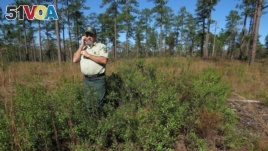05 January 2021
When European settlers came to North America, grassy savannas secured by tall pine trees with footlong needles covered much of the southern part of the continent. Native Americans liked using the needles to make baskets. Hundreds of plant and animal species lived beneath the trees.
Yet by the 1990s, these grasslands and the pine trees above them were almost gone. People had cut the trees for farms and development. The animals were endangered.
Now, two foresters, Rhett Johnson and Dean Gjerstad, are working with landowners, government agencies and nonprofits in nine coastal states from Virginia to Texas. Their goal is to bring back the longleaf pine. The name comes from the tree's long needles.
Johnson and Gjerstad compare themselves to an American folk hero. "We were like Johnny Appleseed -- we were on the road all the time," said Johnson of the years they spent spreading the word about the tree's importance.
Johnny Appleseed was a man who planted apple trees and shared seeds with settlers across the Midwestern U.S. from the 1790s through the 1840s.
Longleaf pines now cover as much as 19,000 square kilometers -- and more than 25 percent of that has been planted since 2010.
"I like to say we rescued longleaf from the dustbin. I don't think we had any idea how successful we'd be," said Johnson. He founded The Longleaf Alliance in 1995 with Gjerstad, a fellow Auburn University forestry professor.

Silviciulturist Keith Coursey stands in a thicket of gallberries -- one of the shrubs that would block the sun from grasses and wildflowers in longleaf pine forests without regular fires -- in front of a stand of 80- to 85-foot-tall longleaf pines in the
Fires can be helpful
One reason for the longleaf's disappearance is the fact that people usually suppress fires, that is, they do not let forests burn. Fires clear and fertilize ground. The longleaf seeds need to grow in rich soil without other plants. If they come at the right time, fires also help young trees as they begin to grow. Fires are important for all the living things in the savanna because they kill shrubs and hardwood trees that would otherwise block the sun from seedlings, grasses and wildflowers.
Keith Coursey is a forest caretaker for about 70 percent of the 214,100 hectare DeSoto National Forest in south Mississippi. "The diversity of the longleaf pine system is below our knees," he said.
Plants, animals and insects live below the trees
There are 16,000 plant species found only in the U.S. Southeast. Almost 900 of those kinds of plants live only in longleaf forests, including species that trap insects as well as the fire-adapted grasses and wildflowers.
The forests shelter turkeys and quail -- but also about 100 other kinds of birds. They also are home to about 40 types of animals and 170 reptile and amphibian species found only among longleaf. One is the gopher tortoise. The tortoise's living areas in the ground also shelter many animal species, including mice, foxes, rabbits, snakes, birds and hundreds of kinds of insects.
By 2005, The Longleaf Alliance, government agencies, nonprofits, universities and private partners were working together. In 2010, they started the America's Longleaf Restoration Initiative, a program that seeks to have 32,370 square kilometers of longleaf by 2025.
Carol Denhof is president of The Longleaf Alliance. She says another 13,360 square kilometers must be planted with the pines to meet the goal. "I'm hopeful we can get there but ... we have a lot of work to do," she said.
Planting trees for basket weavers
The Alabama-Coushatta Tribe of Texas planted about 160 hectares of land with longleaf for their needles. But branches from most of the first planting are now too high for people to reach. So Gesse Bullock, the tribe's fire management specialist, said he is pushing for another planting on the 4,100-hectare reservation.
Elliott Abbey is one of the tribe's basket weavers. "When I was younger," he said, "I thought it was work -- something my aunts made me do."
Now, Abbey says, "It strikes me in the heart that this could die out."
I'm Jill Robbins.
Janet McConnaughey wrote this story for the Associated Press. Jill Robbins adapted it for Learning English. Bryan Lynn was the editor.
_______________________________________________________________
Words in This Story
savanna – n. a large flat area of land with grass and very few trees especially in Africa and South America
needle – n. a leaf that is shaped like a very thin stick
species – n. a group of animals or plants that are similar and can produce young animals or plants
dustbin – n. a can for trash or garbage
shrub – n. a large plant with a rounded shape formed from many small branches
diversity – n. the quality or state of having many different forms, types, ideas or kinds of living things
amphibian – n. an animal (such as a frog or toad) that can live both on land and in water
weaver – n. a person whose job is to weave cloth and other materials (weaves are created by crossing thread over and under each other)
Do foresters carry out similar burns of woods where you live? We want to hear from you. Write to us in the Comments Section.